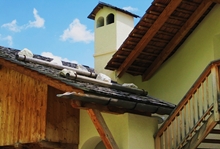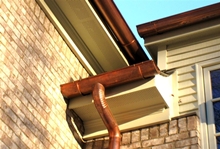Roofs
When selecting a roof for your home or property there are many avenues and options that we offer for you to consider.
Asphalt Shingles are the most common and cost effective form of roofing shingle in use today. They are also known as composition shingles and are reinforced with fiberglass or paper, are manufactured in many styles and last up to 30 years.
Wood Shakes & Shingles are generally manufactured from cedar, spruce or treated pine. Wood shingles are machine cut and smooth on both sides while hand split shakes are generally rough on the front and smooth on the back and last up to 50 years.

Slate Shingles
are essentially shingle like slivers of rock. Slate is an option you will often see on more upscale properties and adds a very natural look to the home, is 100% fire proof, and can last more than 100 years.
Metal Roofing shingles are generally made from steel, aluminum, tin or copper, are available in many styles and colors, and lasts up to 50 years.
Clay Tile Roof overlap and interlock on the roof. They do not absorb as much heat as many other roof options making it an ideal choice for homes in warmer climates, lasting for more than 50 years.
Gutters
Seamless Aluminum Gutters are the most economical and efficient gutter system option. We manufacture the gutters on sight, rolling the aluminum gutter strips from our truck and install in one day. Comes in any color and will not peel or rot.
Vinyl Gutters also an economical choice, retain their color; remain flexible; are relatively easy to repair or replace; don't rust or corrode, and can be painted, if desired. Though with hot sunny temperatures and conditions will destroy vinyl guttering in short order. The gutter will crack under the harsh conditions and break apart, heavy amounts of rain can cause the material to bend and bow, requiring maintenance and replacement, although the option is available, we do not typically recommend its use.
Restoration & Specialty Gutters
Wood Gutters are extremely rare, and typically used only in restoration. Original wood gutters were made from old growth cedar, a product that is rarely available today, however we here at Vulin Construction are able to provide you with this option.
Copper Gutters are also typically reserved for classic restorations. It never rusts, never needs painting and adds a sense of visual appeal, also adding property value requiring less maintenance than other materials. However, even copper will oxidize and turn green over time unless treated, although the look has been fancied by clients but several sealants are available that can be applied to keep copper gutters looking golden and shiny.
Galvanized Steel Gutters are stronger than aluminum, holding sturdy against fallen branches and through rough storms, although eventually thick galvanized steel will rust and require maintenance.
Stainless Steel Gutters Stainless Steel Gutters are strong, rust-free, and maintain their high sheen for years.

Half Round Gutters are found on many turn of the century era homes enable water to flow very effectively and adds a charming style to a home.
Box Gutters , found on older homes, multi-family dwellings, old stores, factories, etc. They were by and large one of the most popular rain collection devices built into and onto structures built between 1880 and 1925. A box gutter does not hang onto the edge of a roof or on the edge or side of a house as many modern pre-formed gutters do. A box gutter is actually built into the bottom of the roof or into the roof overhang.
Fascia Gutters are a rainwater system that is fixed to a fascia board. It is often a custom made rainwater gutter that is fixed to the ends of the rafters and also performs the function of a fascia board. It is most commonly found in the Western part of the United States.